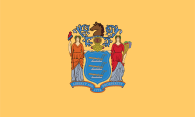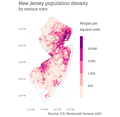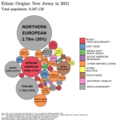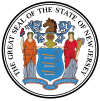Portal:New Jersey
The New Jersey Portal New Jersey is a state in both the Mid-Atlantic and Northeastern regions of the United States. It is the most densely populated state and at the center of the Northeast megalopolis. New Jersey is bordered to the northeast by New York state; on its east, southeast, and south by the Atlantic Ocean; on its west by the Delaware River and Pennsylvania; and on its southwest by Delaware Bay and Delaware. At 7,354 square miles (19,050 km2), New Jersey is the fifth-smallest state in land area, but with close to 9.3 million residents as of the 2020 United States census, it ranks 11th in population. The state capital is Trenton, and the state's most populous city is Newark. New Jersey is the only U.S. state in which every county is deemed urban by the U.S. Census Bureau. New Jersey was first inhabited by Paleo-Indians as early as 13,000 B.C.E. The Lenape were the dominant Indigenous group when Europeans arrived in the early 17th century, and they were subdivived into dialectal groups such as the Munsee, in the north, and the Unami and the Unalachtigo, elsewhere. Dutch and Swedish colonists founded the first European settlements in the state, with the British later seizing control of the region and establishing the Province of New Jersey, named after Jersey. The colony's fertile lands and relative religious tolerance drew a large and diverse population. New Jersey was among the Thirteen Colonies that supported the American Revolution, hosting several pivotal battles and military commands in the American Revolutionary War. New Jersey remained in the Union during the American Civil War and provided troops, resources, and military leaders in support of the Union Army. After the war, the state emerged as a major manufacturing center and a leading destination for immigrants, helping drive the Industrial Revolution in the U.S. New Jersey was the site of many industrial, technological, and commercial innovations. Many prominent Americans associated with New Jersey have proven influential nationally and globally, including in academia, advocacy, business, entertainment, government, military, non-profit leadership, and other fields. (Full article...) Selected article -
Interstate 676 (abbreviated I-676) is an Interstate Highway that serves as a major thoroughfare through Philadelphia, Pennsylvania, where it is known as the Vine Street Expressway, and Camden, New Jersey, where it is known as the northern segment of the North–South Freeway, as well as the Martin Luther King Jr. Memorial Highway. Its western terminus is at I-76 in Philadelphia near the Philadelphia Museum of Art. From there it heads east towards the Ben Franklin Bridge. On the New Jersey side of the bridge, the highway heads south to its southern terminus at I-76 in Gloucester City near the Walt Whitman Bridge. Between the western terminus and downtown Camden, I-676 is concurrent with U.S. Route 30 (US 30).
After World War II, freeway approaches were planned for both sides of the Ben Franklin Bridge, which was completed in 1926 and served as a part of US 30. In Pennsylvania, the Vine Street Expressway was planned to run along the northern edge of Center City Philadelphia to the Schuylkill River, while in New Jersey, the North-South Freeway was to head south along the Route 42 corridor. When the Interstate Highway System was created in the 1950s, this stretch of highway was a part of I-80S, with Interstate 680 continuing on the Schuylkill Expressway to the Walt Whitman Bridge. In 1964, the designations became I-76 and I-676, respectively, and in the 1970s the two routes were switched onto their current alignments. I-676 in New Jersey was completed between I-76 and Morgan Boulevard by 1960 and north of there to downtown Camden by the 1980s. The Vine Street Expressway was opened from the Schuylkill Expressway to 18th Street by 1960 and east of there to the Ben Franklin Bridge on January 10, 1991 after several obstacles to construction. Selected picture - Credit: AEMoreira042281 The Newark Light Rail is a light rail system operated by NJ Transit serving Newark. The service is made up of two segments, the Newark City Subway and the Broad Street Extension. New Jersey news'Related portalsSelected biography - Joseph Emley Borden, aka Joe Josephs, (May 9, 1854 – October 14, 1929), nicknamed "Josephus the Phenomenal", was a starting pitcher in professional baseball for two seasons. Born in the Jacobstown section of North Hanover Township, New Jersey, he was playing for a Philadelphia amateur team when he was discovered by the Philadelphia White Stockings of the National Association (NA) in 1875. The White Stockings needed a replacement for a recently released pitcher, and were awaiting the arrival of a replacement. During his short, seven-game stint with the team, he posted a 2–4 win–loss record, both victories recorded as shutouts. On July 28 of that season, he threw what is thought to be the first no-hitter in professional baseball history. When the NA folded after the 1875 season, Borden signed a three-year contract with the Boston Red Caps. On April 22, 1876, Borden and the Red Caps were victorious in the first National League (NL) game ever played. Later that season, on May 23, he pitched a shutout, which some historians claim was the first no-hitter in Major League Baseball. Known for having an eccentric personality, he played under different surnames, such as Josephs and Nedrob, so as to disguise his involvement in baseball; his prominent family would have disapproved had they known. After he was released from the Red Caps as a player during the first season of his contract, he worked for a short period of time as their groundskeeper until he and the owner agreed to a buyout of the remainder of his contract. It was mistakenly claimed that he died in 1889, in the Johnstown Flood. His official death date is recognized as occurring in 1929 when he was 75 years of age. (Full article...) Did you know? -
General imagesThe following are images from various New Jersey-related articles on Wikipedia.
TopicsQuality content
CategoriesThings you can do
For more information on how you can help, see the WikiProject New Jersey. Associated WikimediaThe following Wikimedia Foundation sister projects provide more on this subject:
Discover Wikipedia using portals |











































































